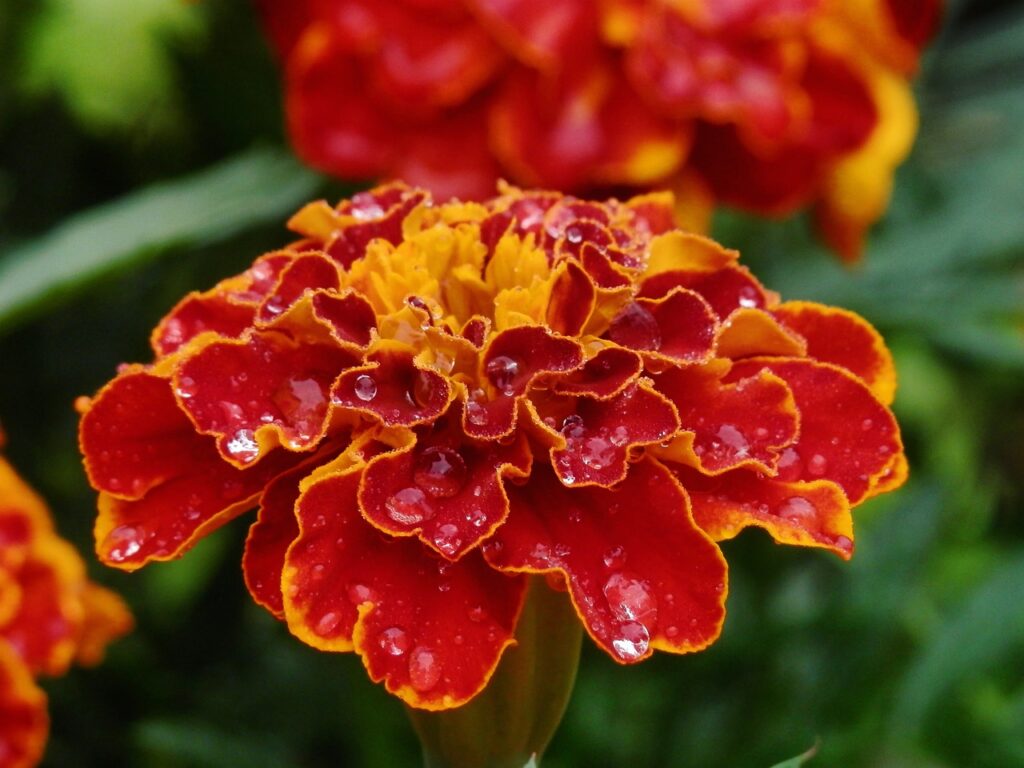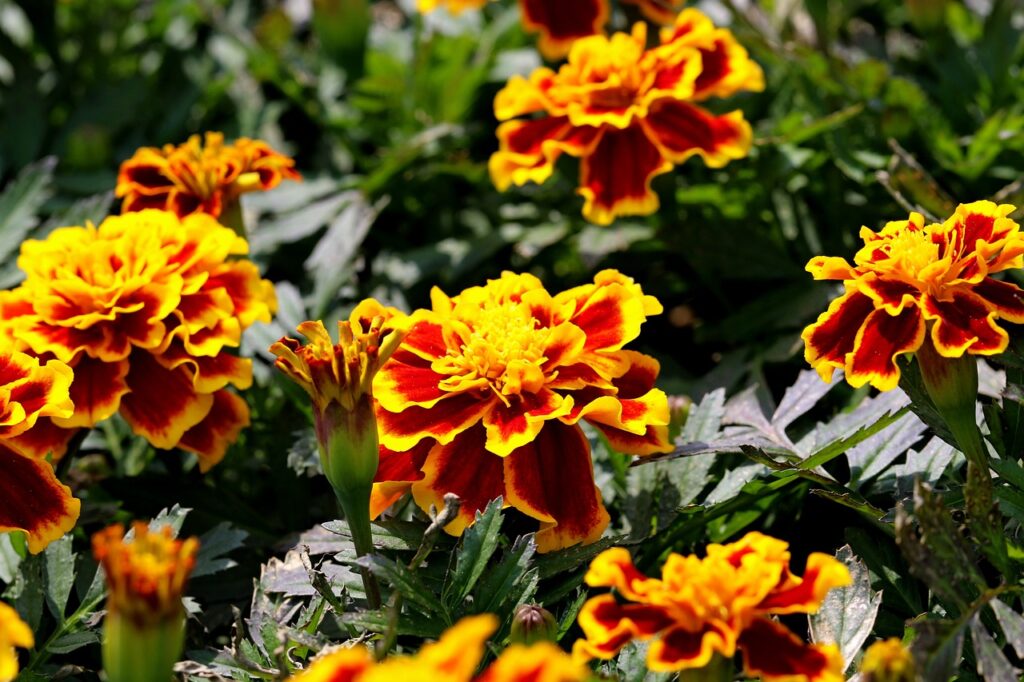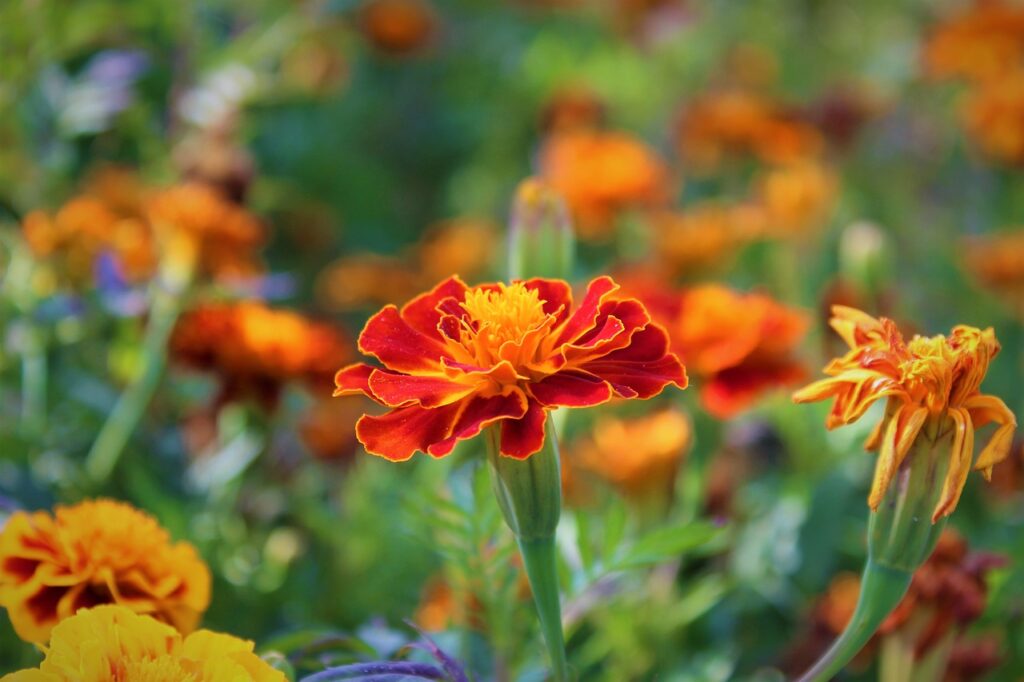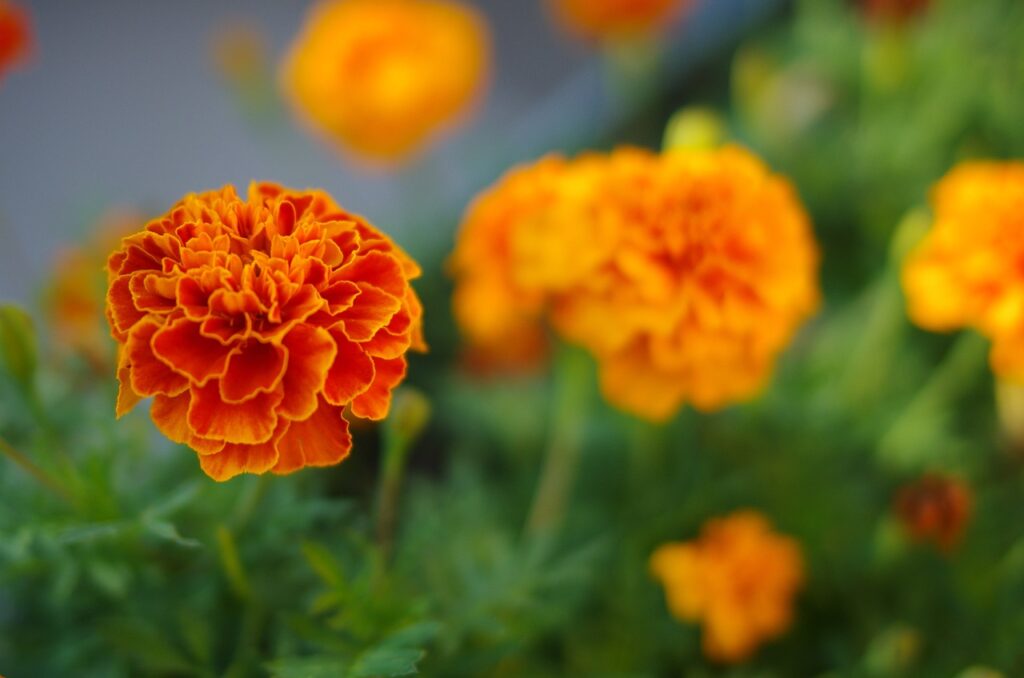French Marigolds, scientifically known as Tagetes patula, are a popular and vibrant addition to any garden. Renowned for their richly colored flowers, which range from shades of yellow and orange to deep red, French Marigolds are a gardener’s delight. Growing French marigolds from seed is easy and their bright vibrancy brings cheer to garden beds and containers.
Typically, French Marigolds grow to a mature height of about 6 to 18 inches and spread approximately 6 to 12 inches, forming a dense, bushy mound of small, finely-textured foliage and prolific flowers. Their compact size makes them ideal for borders, pots, and as companion plants in vegetable gardens.
Native to Mexico and Central America, French Marigolds have adapted well to a variety of climates. They are commonly grown as annuals in USDA Hardiness Zones 2 through 11. These flowers are particularly valued for their ability to thrive in hot, sunny environments and are known for their pest-repelling properties, making them a favorable choice for both aesthetic and practical gardening needs.
When to Start Growing French Marigolds from Seed

Timing is key when it comes to planting French Marigolds (Tagetes patula). Whether you’re starting seeds indoors or sowing directly into your garden, understanding the right timing for your specific USDA Hardiness Zone will ensure the best growth and flowering.
In Zones 3-5
In these cooler climates, begin sowing seeds indoors about 6-8 weeks before the last expected frost date. This gives the seedlings enough time to grow strong before moving them outdoors.
You can sow seeds directly into the garden once the danger of frost has passed and the soil has warmed up, usually in late spring.
In Zones 6-8
Start seeds indoors 4-6 weeks before the last frost date. This allows for a longer flowering period in your garden.
After the risk of frost is gone, usually in early spring, you can sow the seeds directly in your garden.
In Zones 9-12
In these warmer areas, starting seeds indoors around 4-6 weeks before the last frost date can still be beneficial, especially for getting a jump on the growing season.
Direct sowing can be done as early as late winter or early spring, as the climate is generally mild.
For all zones, starting seeds indoors is a great way to get an early start on the growing season. Marigold seeds typically germinate within a week in the right conditions, allowing for a quick and satisfying start to your gardening.
How to Start French Marigolds Seeds in Cell Trays or Soil Blocks

Starting French Marigold seeds indoors is a straightforward process that can lead to earlier blooms and a longer flowering season. Here’s how to effectively start your seeds:
Choosing or Making a Seed Starting Mix
French Marigolds thrive in a light, well-draining seed starting mix. A good mix can be made by combining peat moss, vermiculite, and perlite in equal parts. This blend ensures proper drainage and aeration, key elements for seed germination.
Choosing Containers for Starting Seeds
Select containers or cell trays that are relatively deep to accommodate the growth of the marigolds’ roots. Containers about 3-4 inches deep are ideal. This depth provides ample space for the roots to develop, which is crucial for the health of the seedlings.
Depth to Plant
Sow the seeds at a shallow depth of about 1/8 inch. A thin covering of soil is sufficient to protect the seeds while still allowing light to reach them, which is essential for germination.
Moisture Requirement for Seeds
The soil should be kept consistently moist but not waterlogged. Use a spray bottle to mist the soil gently, ensuring it stays hydrated without becoming overly saturated.
Optimal Temperature for Germination
French Marigolds germinate best at a temperature of 70-75°F (21-24°C). This warm environment can be maintained in a greenhouse, near a sunny window, or with the use of a heat mat.
Light Requirements for Germination
These seeds require good light for germination. Place the seed trays in a well-lit area or under a grow light. Adequate light is crucial for the development of strong, healthy seedlings.
Time to Germination
Under optimal conditions, French Marigold seeds usually germinate within 5 to 7 days, but it can take up to two weeks in some cases.
How to Prepare Garden Bed for Growing French Marigolds

To ensure the best growth and vibrant blooms of your French Marigolds (Tagetes patula), proper preparation of the garden bed is essential. Here’s a detailed guide on how to prepare your garden:
French Marigolds flourish in full sun. Choose a location that receives at least 6-8 hours of direct sunlight daily. Ample sunlight is crucial for healthy growth and maximum flowering.
Opt for an area with well-draining soil. While French Marigolds can tolerate some dryness, they perform best in soil that holds moisture without becoming waterlogged.
These flowers prefer fertile, well-drained soil. They grow well in a variety of soil types but thrive in loamy or sandy soil with a neutral to slightly acidic pH. If your garden soil is heavy clay or very sandy, consider amending it with organic matter to improve its structure and fertility.
Preparing the Garden Bed

Begin by clearing the site of weeds, grass, and other debris. This ensures the marigolds will not have to compete for resources.
Loosen the soil gently using a garden fork if compacted.
Add a layer of compost or well-rotted manure if your soil is poor. This step enhances soil fertility and improves its structure, promoting healthier plant growth.
Use a rake to even out the surface. This makes planting easier and ensures even distribution of water and nutrients.
Lightly water the prepared bed to provide a moist base for planting.
Direct Sowing French Marigolds

Directly sowing French Marigolds (Tagetes patula) in your garden is an effective way to establish these vibrant flowers. Here are the steps to ensure successful sowing:
Depth to Plant
Sow French Marigold seeds at a shallow depth, about 1/4 inch beneath the soil surface. A light covering of soil is enough to protect the seeds while still allowing for sufficient light penetration and air circulation, which are essential for germination.
Spacing
When scattering the seeds, aim for a spacing of about 8 to 10 inches apart. If you’re sowing seeds in rows, keep the rows spaced about 12 inches apart. This spacing allows each marigold plant enough room to develop fully and promotes good air circulation, reducing the risk of disease.
Watering In After Planting
After sowing, water the area gently but thoroughly. The goal is to moisten the soil without disturbing the seeds. Use a watering can with a fine rose or a gentle spray setting to avoid displacing the seeds. Keeping the soil consistently moist during germination is key.
Thinning
Once the seedlings emerge and grow a few inches tall, thin them to maintain the spacing of about 8 to 10 inches. This process ensures that each plant has sufficient space to grow and receive adequate sunlight and nutrients.
Mulching
Applying a thin layer of organic mulch around the seedlings can help retain soil moisture, maintain a consistent soil temperature, and suppress weed growth. Be cautious not to apply the mulch too thickly around the young plants to prevent rot.
How to Know When Your French Marigold Starter Plants are Ready

Identifying the right time to transplant your French Marigold (Tagetes patula) starter plants is crucial for their successful transition to the garden or larger containers. Here are the key indicators:
Size and Development: Starter plants are ready for transplanting when they have reached a height of about 2-3 inches and have developed several sets of true leaves. True leaves are the leaves that emerge after the initial seed leaves (cotyledons).
Root Growth: Check the roots by gently lifting the plant from its starter container. The roots should be well-developed and visible, but not overly crowded or tangled.
Planting Out French Marigold Starters

Once your French Marigold starters are ready, here’s how to plant them out in your garden:
Depth
Plant the starters at the same depth they were growing in their containers. This helps the plants adjust without experiencing shock or root exposure.
Spacing
Space the plants about 8-10 inches apart. Proper spacing allows for adequate air circulation and room for growth, reducing the likelihood of disease and competition for nutrients.
Mulching
After planting, apply a light layer of organic mulch around the plants. Mulch helps conserve soil moisture, suppress weeds, and maintain an even soil temperature. Avoid piling mulch directly against the plant stems to prevent rot.
Watering In After Planting
Water the transplants thoroughly after planting. This initial watering helps settle the soil around the roots and provides essential moisture for the plants to start establishing themselves. Ensure consistent moisture, especially during the first few weeks after planting, to support healthy growth.
Caring for French Marigolds

French Marigolds are relatively low-maintenance, making them ideal for both beginner and experienced gardeners. They thrive with basic care, including regular watering, occasional feeding, and routine weeding. Proper care results in a lush display of colorful blooms and a healthy garden.
Watering
Water your Marigolds thoroughly, especially during dry spells. They prefer consistent moisture but are also quite drought-tolerant once established. Avoid overwatering, as Marigolds do not like to sit in wet soil. Ensure the soil is well-drained and let the top inch dry out between waterings.
Feeding
Feed your French Marigolds with a balanced, all-purpose fertilizer once at the beginning of the growing season. They are not heavy feeders, so light fertilization is sufficient. Over-fertilizing can lead to lush foliage at the expense of blooms.
Weeding
Keep the area around your Marigolds free of weeds. Weeds compete for nutrients and water, which can hinder the growth of your flowers. Regular weeding and mulching help maintain a clean and healthy garden bed.
Tips and Tricks for Growing French Marigolds

Here are some additional tips and tricks to ensure the best growth and flowering of your French Marigolds:
Deadheading: Regularly remove spent blooms (deadheading) to encourage more flowering and extend the blooming period.
Pest Control: French Marigolds are known for their ability to repel certain garden pests. Plant them near vegetables and other flowers as a natural pest deterrent.
Soil Quality: Although Marigolds are adaptable to various soil types, they flourish in well-draining soil enriched with organic matter.
Positioning: Plant French Marigolds in a sunny spot to maximize their flowering potential.
Companion Planting: Marigolds make excellent companion plants for vegetables like tomatoes and peppers, as they can help repel harmful pests.
What to Expect from French Marigolds Over Winter

French Marigolds are typically grown as annuals. This means they complete their life cycle in one growing season and usually die off with the first hard frost.
As the temperatures drop and frost occurs, Marigolds will begin to brown and die back. They are not frost-tolerant plants.
Before the first frost, consider collecting seeds from your healthiest Marigold plants. This allows you to replant them the following spring.
In most climates, French Marigolds will not survive the winter outdoors. In regions without freezing winter temperatures, some may survive but will generally not perform as well as new plants grown from seeds.
French Marigolds are a vibrant and joyful addition to any garden, offering a burst of color and beauty.
Their ease of care, coupled with their pest-repellent qualities, makes them a favorite among gardeners.
